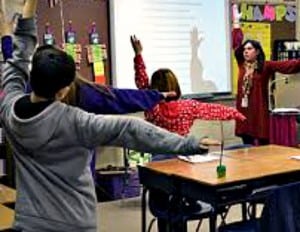
The researchers engaged 30 third-grade and fourth-grade students in a mathematics learning task. Students participated in movement-based instruction to learn about angles. The students moved their arms to form acute, right, obtuse, and straight angles. Their movements were projected on a large screen using Kinect for Windows, a motion-detection program that allows users to interface with the program through movement. On the screen, the types of angles were each represented by a different color. An on-screen protractor helped students refine their movements.
The study demonstrates that a more dynamic learning environment can be more beneficial for student learning. Students who moved their bodies in the movement-based instruction had significantly higher learning gains compared to the students who focused on static representations of angles.
Researcher and study author Carmen Petrick Smith, assistant professor of mathematics education, explains that movement gives students a way to express concepts that they may not be able to articulate. “When students are acting out a math problem and using their body to help them explain the answer, that’s another modality. Maybe they don’t know the words quite yet, but they have a way to express it using their body that they didn’t have before when they were sitting in a row of desks looking up at the teacher and searching for an answer.”
The study comes from an emerging field called ‘embodied cognition’, which posits that the brain alone does not generate behavior, rather the brain works with physical movements, emotions, and perceptions. The findings offer evidence that deviating from static math instruction could benefit students.
This research is published in the Journal of Mathematical Behavior.
Previous news:



 © 2025 Unyte Health US Inc.
© 2025 Unyte Health US Inc.